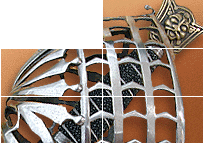| Author |
Message |
|
Jeremiah Swanger
|
 Posted: Sat 04 Sep, 2004 2:43 pm Post subject: Hilt-and-scabbard-related questions... Posted: Sat 04 Sep, 2004 2:43 pm Post subject: Hilt-and-scabbard-related questions... |
 |
|
Hi all,
I have a pair of questions about hilt and scabbard work...
1) Are there any historical examples of *European* sword grips being wrapped with braided cord (not wire) made of silk, linen, or cotton; without having leather wrapped over it?
2) I've noticed a bunch of Japanese saya, both historical and reproduction, tend to be extremely selective with regards to the wood type and grain. Scott Slobodian, for example, has made several saya from flamed maple (aka "tiger maple") which was then dyed. Honestly, I absolutely love the look of dyed and oiled wood. Would it be too big a stretch for some of the nobility to possess scabbards made of dyed and lacquered exotic hardwoods? Or did they all have a leather wrap?
3) Regarding hilt and scabbard woods-- Are there specific woods that were used in grips and scabbards? For example, Albion uses Birch in their grips-- is there any particular reason why Birch and not, say, Poplar or Alder?
Thanks in advance!
"Rhaegar fought nobly.
Rhaegar fought valiantly.
Rhaegar fought honorably.
And Rhaegar died."
- G.R.R. Martin's A Song of Ice and Fire
|
|
   |
 |
|
Geoff Wood
|
 Posted: Sun 05 Sep, 2004 9:50 am Post subject: Re: Hilt-and-scabbard-related questions... Posted: Sun 05 Sep, 2004 9:50 am Post subject: Re: Hilt-and-scabbard-related questions... |
 |
|
| Jeremiah Swanger wrote: |
3) Regarding hilt and scabbard woods-- Are there specific woods that were used in grips and scabbards? For example, Albion uses Birch in their grips-- is there any particular reason why Birch and not, say, Poplar or Alder?
Thanks in advance! |
I imagine that they might not use birch if they weren't using it laminated, given its tendency to splitting, but of course the laminating gets over that problem. Birch is commonly used in plywoods, so maybe it was more the availability of ready laminated wood rather than the wood as such that was the decider, but I'm obviously just guessing. I don't know if laminating was the historical approach (doesn't look like if from some relics, but my knowledge is very limited).
As for scabbards, I think stiffness and lightness may have been most important, so maybe light woods that you could readily get thin strips from may have been used, e.g. pine. I've managed to make a durable scabbard with balsa strips, so provided the construction is OK I'm guessing (again) that anything light would work.
Geoff
|
|
  |
 |
|
Lee O'Hagan
|
 Posted: Sun 05 Sep, 2004 12:58 pm Post subject: Posted: Sun 05 Sep, 2004 12:58 pm Post subject: |
 |
|
Bang on the money Geoff,
Albion's hilt description states stabilized birch,
For the hilt i think poplar being a softwood may not have been used unless that was all that was available,
I recently had a scabbard made that was'nt really historically accurate, visually.
But that said it is detailed plain wood that if i was to move the package on,
it is only a case of using the scabbard as the core, not a problem,
If you have a personnal preference, why not  your money after all, your money after all,
|
|
  |
 |
Chad Arnow
myArmoury Team


|
 Posted: Mon 06 Sep, 2004 10:16 am Post subject: Re: Hilt-and-scabbard-related questions... Posted: Mon 06 Sep, 2004 10:16 am Post subject: Re: Hilt-and-scabbard-related questions... |
 |
|
| Jeremiah Swanger wrote: | Hi all,
I have a pair of questions about hilt and scabbard work...
1) Are there any historical examples of *European* sword grips being wrapped with braided cord (not wire) made of silk, linen, or cotton; without having leather wrapped over it? |
Jeremiah,
Oakeshott describes grips wrapped with cord over the main covering in a diapered pattern, or wire and silk thread used together as a wrapping. Sometimes velvet was used as a covering instead of leather.
As for braided cord, I haven't read about that being used.

ChadA
http://chadarnow.com/
|
|
    |
 |
|
Joel Whitmore
Location: Simmesport, LA Joined: 25 Aug 2003
Posts: 342
|
 Posted: Tue 07 Sep, 2004 8:41 am Post subject: Scabbard woods Posted: Tue 07 Sep, 2004 8:41 am Post subject: Scabbard woods |
 |
|
|
Some woods, especially oak, have acids in them. Just wet some oak sawdust and watch the reaction on your concrete! I don't think pine would have been a good idea beacause of the resin in the wood. Poplar seemed to be a popular (pardon the pun) choice for the survuving medieval scabbards. It is light, dry and has a very straight grain for carving out the inside to fit the sword.
|
|
    |
 |
|
|
You cannot post new topics in this forum
You cannot reply to topics in this forum
You cannot edit your posts in this forum
You cannot delete your posts in this forum
You cannot vote in polls in this forum
You cannot attach files in this forum
You can download files in this forum
|
All contents © Copyright 2003-2025 myArmoury.com — All rights reserved
Discussion forums powered by phpBB © The phpBB Group
Switch to the Basic Low-bandwidth Version of the forum
|

